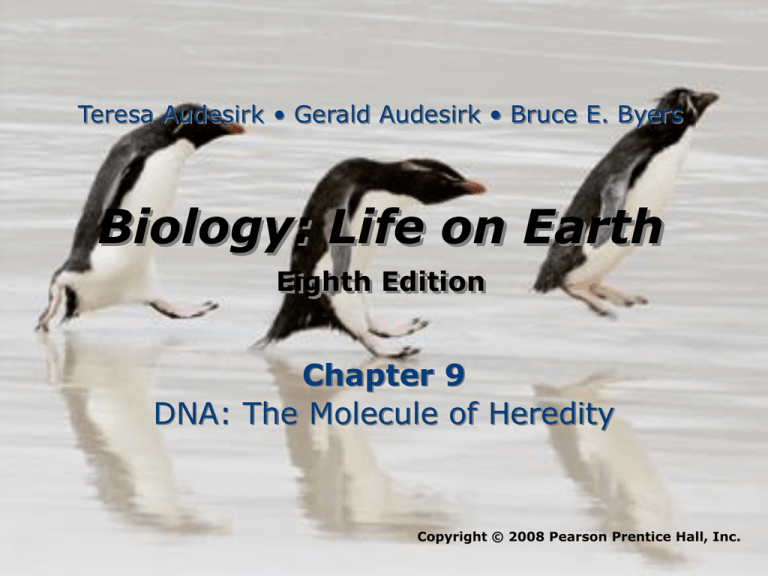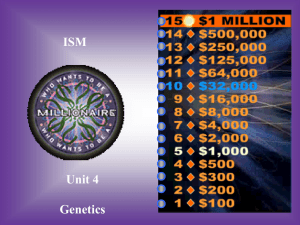
Teresa Audesirk • Gerald Audesirk • Bruce E. Byers
Biology: Life on Earth
Eighth Edition
Chapter 9
DNA: The Molecule of Heredity
Copyright © 2008 Pearson Prentice Hall, Inc.
Chapter 9 Opener Biology: Life on Earth 8/e ©2008 Pearson Prentice Hall, Inc.
Bacterial strain(s) injected into mouse
Results
Mouse remains
healthy.
Living
R-strain
Conclusions
R-strain does not
not cause
pneumonia.
Mouse contracts
pneumonia, dies.
S-strain causes
pneumonia.
Living
S-strain
Mouse remains
healthy.
Heat-killed
S-strain
Living R
strain,
heat-killed
S-strain
Figure 9-1 Biology: Life on Earth 8/e ©2008 Pearson Prentice Hall, Inc.
Heat-killed Sstrain does not
cause pneumonia.
Mouse contracts A substance from
pneumonia, dies. heat-killed S-strain
can transform the
harmless R-strain
into a deadly
S-strain.
bacterial
chromosome
DNA fragments are
transported into
bacterium.
DNA fragment is
incorporated into
chromosome.
Figure 9-2 Biology: Life on Earth 8/e ©2008 Pearson Prentice Hall, Inc.
DNA
head
tail
Figure E9-1a Biology: Life on Earth 8/e ©2008 Pearson Prentice Hall, Inc.
phage
6 Bacterial wall
destroyed; phage
released.
phage
chromosome
1 Phage attaches
to bacterium.
bacterium
bacterial
chromosome
2 Phage injects its
chromosome into
bacterium.
5 Complete
phages assembled.
4 Phage parts
synthesized, using
bacterial metabolism.
Figure E9-1b Biology: Life on Earth 8/e ©2008 Pearson Prentice Hall, Inc.
3 Phage chromosome
is replicated.
Observations:
1. Bacteriophage viruses consist of only DNA and protein.
2. Bacteriophage inject their genetic material into bacteria, forcing the bacteria to synthesize more phages.
3. The outer coat of bacteriophages stays outside of the bacteria.
4. DNA contains phosphorus but not sulfur.
a. DNA can be “labeled” with radioactive phosphorus.
5. Protein contains sulfur but not phosphorus.
a. Protein can be “labeled” with radioactive sulfur.
Question: Is DNA or protein the genetic material of bacteriophages?
Hypothesis: Radioactive phosphorus (P32)
Prediction:
1. If bacteria are infected with bacteriophages containing radioactively labeled DNA, the bacteria will be
radioactive.
2. If bacteria are infected with bacteriophages containing radioactively labeled protein, the bacteria will not
be radioactive.
Figure E9-2 (part 1) Biology: Life on Earth 8/e ©2008 Pearson Prentice Hall, Inc.
Radioactive phosphorus (P32)
Radioactive sulfur (S35)
Radioactive
DNA (blue)
Radioactive
protein
(yellow)
1 Label phages with P32 or S35.
2 Infect bacteria with
labeled phages; phages inject
genetic material into bacteria.
3 Whirl in blender to break off
phage coats from bacteria.
4 Centrifuge to separate phage coats
(low density: stay in liquid)
from bacteria (high density:
sink to bottom as a “pellet”)
5 Measure radioactivity of phage
Results: Bacteria are
Results: Phage coats are
coats and bacteria.
radioactive; phage coats are not.
radioactive; bacteria are not.
Conclusion: Infected bacteria are labeled with radioactive phosphorus but not with radioactive sulfur,
supporting the hypothesis that the genetic material of bacteriophages is DNA, not protein.
Figure E9-2 (part 2) Biology: Life on Earth 8/e ©2008 Pearson Prentice Hall, Inc.
phosphate
sugar
base = adenine
phosphate
sugar
base = guanine
Figure 9-3 (part 1) Biology: Life on Earth 8/e ©2008 Pearson Prentice Hall, Inc.
phosphate
base = thymine
sugar
phosphate
base = cytosine
sugar
Figure 9-3 (part 2) Biology: Life on Earth 8/e ©2008 Pearson Prentice Hall, Inc.
Figure 9-4 Biology: Life on Earth 8/e ©2008 Pearson Prentice Hall, Inc.
free phosphate
free sugar
Figure 9-5 Biology: Life on Earth 8/e ©2008 Pearson Prentice Hall, Inc.
Figure E9-3 Biology: Life on Earth 8/e ©2008 Pearson Prentice Hall, Inc.
1 Parental DNA
double helix
2 Parental DNA
unwound
3 New DNA strands
synthesized with
bases complementary
to parental strands
free nucleotides
4 New double helix composed of one parental
strand and one new strand
Figure 9-6 Biology: Life on Earth 8/e ©2008 Pearson Prentice Hall, Inc.
One DNA
double helix
DNA replication
Two identical DNA
double helixes, each
with one parental
strand and one new
strand
Figure 9-7 Biology: Life on Earth 8/e ©2008 Pearson Prentice Hall, Inc.
5 end
5 4
6
5
1
4
3
2
3 end
Figure E9-4 Biology: Life on Earth 8/e ©2008 Pearson Prentice Hall, Inc.
3
1 2
5 end
5
1
5 4
6 3
1 2
4
3
5
2
1
8 7
9
4
3
2
3 end
Figure E9-5 Biology: Life on Earth 8/e ©2008 Pearson Prentice Hall, Inc.
5 4
6 3
1 2
5 end
3 end
3 end
Figure E9-6 Biology: Life on Earth 8/e ©2008 Pearson Prentice Hall, Inc.
5 end
replication bubbles
DNA
DNA helicase
replication forks
Figure E9-7ab Biology: Life on Earth 8/e ©2008 Pearson Prentice Hall, Inc.
DNA helicase
replication forks
DNA
polymerase #1
3
5
3
DNA
polymerase #2
Figure E9-7bc Biology: Life on Earth 8/e ©2008 Pearson Prentice Hall, Inc.
5
DNA
polymerase #1
3
5
3
DNA
polymerase #2
DNA polymerase #1
continues along
parental DNA strand
5
3
DNA
polymerase #3
Figure E9-7cd Biology: Life on Earth 8/e ©2008 Pearson Prentice Hall, Inc.
5
3
5
3
5
DNA
polymerase #2
leaves
DNA polymerase #1
continues along
parental DNA strand
5
3
DNA
polymerase #3
5
3
DNA
polymerase #4
3
DNA
5 polymerase #2
leaves
3
5
3
5
3
DNA
polymerase #3
leaves
5
3
5
DNA ligase joins
daughter DNA strands
together.
Figure E9-7de Biology: Life on Earth 8/e ©2008 Pearson Prentice Hall, Inc.
Nucleotide substitution
original DNA sequence
substitution
nucleotide pair changed from A–T to T–A
Figure 9-8a Biology: Life on Earth 8/e ©2008 Pearson Prentice Hall, Inc.
Insertion mutation
original DNA sequence
T–A nucleotide pair
inserted
Figure 9-8b Biology: Life on Earth 8/e ©2008 Pearson Prentice Hall, Inc.
Deletion mutation
original DNA sequence
C–G nucleotide pair
deleted
Figure 9-8c Biology: Life on Earth 8/e ©2008 Pearson Prentice Hall, Inc.
Inversion
original DNA sequences
breaks
DNA segment inverted
Figure 9-8d Biology: Life on Earth 8/e ©2008 Pearson Prentice Hall, Inc.
Translocation
original DNA sequences
break
DNA
segments
Switched
break
Figure 9-8e Biology: Life on Earth 8/e ©2008 Pearson Prentice Hall, Inc.
Figure 9-9 Biology: Life on Earth 8/e ©2008 Pearson Prentice Hall, Inc.








